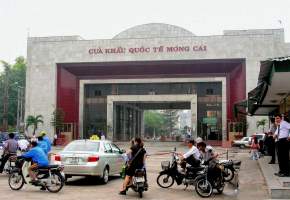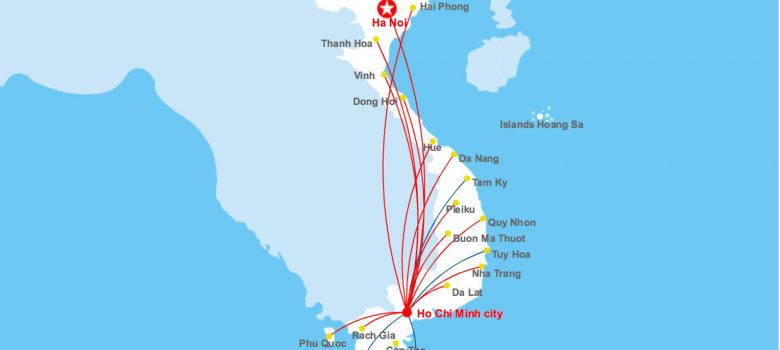
Planes & air travel
Air travel
Air travel to and within Vietnam has improved significantly over recent years. Prior to the COVID 19 pandemic, there were a wide variety of international flight connections into and out of the hubs of Ho Chi Minh and Hanoi, as well as a plethora of domestic flight choices. Getting about by plane was simple and efficient.
It remains to be seen how quickly things recover as Vietnam opens up once more to international tourism, expected sometime in 2022.
The text below describes air travel before the pandemic. There are bound to be changes going forward — most likely more COVID checks and new requirements at points of entry. Travelers will need to check the details before each trip. Hopefully, however, much of the information we present below will still be relevant.
Major renovations in recent years at both Ho Chi Minh and Hanoi airports have created modern, large, clean terminals that mostly work well, even with large volumes of passengers.
Da Nang, which accepts a far smaller number of international flights, is home to a third international airport, and Phu Quoc, an island in the south of Vietnam, also has an international airport, with even fewer international flights. Over a dozen other domestic airports are scattered across Vietnam.
With new airlines on both international and domestic routes, competition has increased, pricing is sharper and the quality of both international and domestic aircraft servicing the country is better.
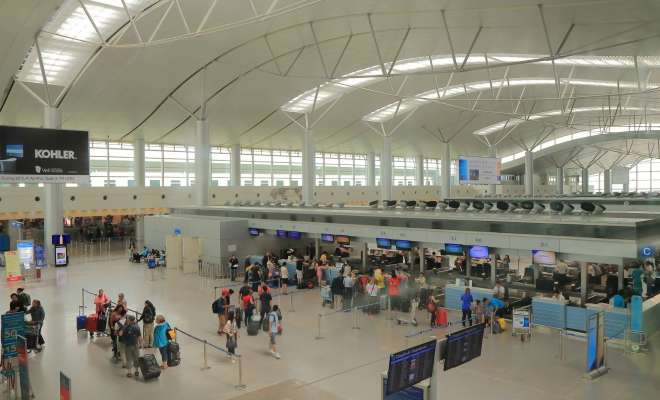
However, air travel can still have its challenges. Ho Chi Minh and Hanoi airports can both be extremely busy, with long queues at peak times (especially around the new year festival of Tet, in late January or early February).
Delays and flights cancelled with little notice can and do happen, especially with the lower cost and budget regional airlines, and flights connecting through China. Connections with the major international hubs of Bangkok and Singapore can also not go smoothly.
Basic services inside the terminals such as shops, ATMs & wifi are mostly good but can on occasion be out of service, even at Ho Chi Minh and Hanoi. Since you cannot buy Vietnamese Dong outside of Vietnam, if the ATM is down this can be a problem!
Adding to difficulties, especially for travelers new to Vietnam, is the volume of poor information on the internet.
Here we have gathered some information that we hope might be useful to travelers and which is not always easily or reliably found on the internet.
Airports and connections
Most travelers arrive in Vietnam via Ho Chi Min’s Tan Son Nhat airport (SGN) or Hanoi’s Noi Bai airport (HAN). Entry via Da Nang (DAD) might make sense if you wanted to visit Hoi An or Hue first off, but in most cases it is probably easier and likely cheaper to come via Ho Chi Minh or Hanoi.

The island of Phu Qhoc in the south of Vietnam also has a small international airport (PCQ) designed mainly to support tourists holidaying there — you can visit Phu Quoc without having a full entry visa, but you cannot proceed on to the rest of Vietnam without obtaining a proper visa.
Many international airlines route through Bangkok or Singapore airports, and you will likely need to transfer, especially if you are coming to Hanoi, from one of these hubs (Ho Chi Minh city accepts more international flights than Hanoi).
If you’re coming from further afield, for example Europe or North America, it often works out to be more cost effective, but occasionally more time consuming, to purchase a long-haul ticket into one of the Southeast Asian hubs and then carry on to Vietnam with a budget carrier.
If you change airlines to a regional carrier for the final leg to Vietnam, be aware that delays and cancellations of flights to both Ho Chi Minh and Hanoi can and do happen, sometimes with very little warning.
If you have a tight schedule after first arriving in Vietnam — to start a tour, or to fly on to another destination for example — then you should think of allowing for a generous layover in Bangkok or Singapore to give slippage time in case of flight delays or cancellations.
Both Ho Chi Minh and Noi Bai airports offer visa on arrival.
Some people say that this is the best approach, but in our experience the queues and the process to do this can be very frustrating. You might get your visa on arrival smoothly in 3 minutes, or there could be a problem with some of the people in front of you in the queue and you could spend a long time waiting and even miss a connecting flight.
We have had this experience ourselves a few times and swore never again.
The process has improved over recent years, but for most travelers from most countries we still suggest getting your visa sorted before you leave home. See here for more details on visas.
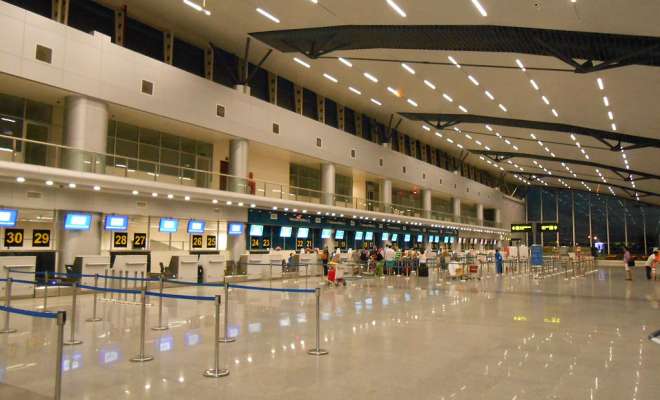
Most international flights fly to Hanoi via Ho Chi Minh, meaning you will have to go through immigration and customs at Ho Chi Minh and collect your bags before checking in at the domestic terminal (a short 5 – 10 min walk from the exit to the international terminal — turn right and follow the covered walkway) for a domestic flight to Hanoi.
The domestic terminal can be very busy with long queues at peak times, and it can take a while to find your way around, so allow sufficient time before your connecting flight.
For Vietnam Airlines, domestic security and boarding gates are one flight up — find ground floor entrance D1 and look for an escalator up to departures. Also note that the boarding gate assigned to a flight can change even close to departure time, and it is not always announced, so you need to check regularly.
If you are flying internationally with Vietnam Airlines as well as for your connecting domestic flight, and have boarding passes for both legs, then Vietnam Airlines staff will collect your bags for transfer to the domestic flight just before you exit the international terminal (ask if you can’t find them).
This means at the domestic terminal you only have to go through normal domestic security and make your way to the departure lounge, thus avoiding any long queues at domestic check in.
Vietnam Airlines also often provides dedicated luggage carousels within the international terminal for bags connecting to domestic Vietnam Airlines flights.
This can speed up luggage retrieval time significantly, but it can also be a pain if you are waiting anxiously at the normal carousel while your bag is doing loops on the dedicated carousel. Ask the staff at the carousels.
It is also a good idea to keep your baggage check / receipt handy (normally stuck to your boarding pass), as there can be a check of your receipt against your baggage on leaving the terminal, something we have rarely experienced outside Vietnam.
Regional, domestic & international flights
There are more than a dozen regional airports within Vietnam, covering most of the country (click here for the latest online Vietnam Airlines domestic and international route maps).
Flights are not expensive and connections are mostly OK, and given the size of Vietnam (some 1,650 kilometers from north to south), air travel is a great way to cover longer distances.
Even if you’re traveling with a motorbike, you can easily put the bike on a bus a day or so before your flight, or on a train or bus two to three days before your flight and pick it up in a town not far from the airport when you arrive — see here for more information on traveling by motorbike.
A combination of regional airport travel and a slower exploration of each region by private car & driver is another fantastic option for maximizing your Vietnam experience.
Hiring a car & driver in each location and spending more time experiencing back roads rather than driving along main roads is a great way to go.
Domestic & regional airlines
For domestic travel within Vietnam, as well as travel to other neighboring Asian countries, we recommend the following airlines:
- Vietnam Airlines (www.vietnamairlines.com) is Vietnam’s national carrier. It has a comprehensive domestic network and a growing international one. We use it ourselves.
- Jetstar (http://www.jetstar.com/) is our second choice of domestic (low cost carrier “LCC”) carrier with a more limited network, but its rates tend to be slightly lower than Vietnam Airlines. It also has flights to a few international destinations, mostly in Asia, plus Australia and New Zealand.
- Viet Jet (http://www.vietjetair.com/Sites/Web/vi-VN/Home) is a third (discount) carrier with an even more limited network, also offering flights to a few Asian destinations.
- Air Asia (http://www.airasia.com/vn/en/home.page) is a fourth (discount) carrier, and although it does not offer any domestic flights, it does fly to a number of Asian countries, as well as to other non-Asian countries such as Australia, New Zealand, Maldives, Nepal, Oman, and Iran.
- Tiger Air (http://www.tigerair.com/vn/en/) is a fifth recommendation, and while it does not fly domestically, it does operate services from Hanoi and HCM city to regional destinations in Southeast Asia, as well as China, India, Bangladesh, Japan, Maldives and Australia.
- Bamboo Airways (https://www.bambooairways.com/en/), is making waves in the domestic market, offering flights to and from about 15 different locations within the country.
Just be aware that the budget carriers tend to delay or cancel flights more often, sometimes with little or no warning.
Also be mindful of flights that arrive in Ho Chi Minh or Hanoi as part of a route that has visited other countries where delays are common (ask your travel agent), because this increases significantly the risk of delay or cancellation of your final leg.
Since the lower cost carriers tend to have fewer flights and viable connections, the consequences of any delay or cancellation can be more severe — you may have to wait longer or simply buy another ticket to get where you want to go.
If you are on a schedule that does not allow for a lost day here or there, then in our experience it may be advisable to avoid the lower cost carriers.
International carriers
A growing number of international carriers (both full service and LCCs) are now flying to and from Vietnam, including the following:
- Aeroflot (Hanoi)
- Air Asia (Hanoi)
- Air China (Ho Chi Minh City)
- Air France (Hanoi, Ho Chi Minh City)
- ANA (Ho Chi Minh City)
- Asiana (Ho Chi Minh City)
- Bangkok Airways (Ho Chi Minh City)
- Cathay Pacific (Hanoi, Ho Chi Minh City)
- China Airlines (Hanoi, Ho Chi Minh City)
- China Eastern (Ho Chi Minh City)
- China Southern (Hanoi)
- EVA Air (Hanoi, Ho Chi Minh City)
- Hong Kong Airlines (Hanoi, Ho Chi Minh City)
- JAL (Hanoi, Ho Chi Minh City)
- Jetstar Hanoi, Ho Chi Minh City)
- Korean Air (Hanoi, Ho Chi Minh City)
- Lao Airlines (Hanoi)
- Lufthansa (Hanoi, Ho Chi Minh City)
- Malaysia Airlines (Hanoi, Ho Chi Minh City)
- Philippine Airlines (Ho Chi Minh City)
- Qantas (Ho Chi Minh City)
- Qatar Airlines (Hanoi, Ho Chi Minh City)
- Royal Brunei Airlines (Ho Chi Minh City)
- Scoot (Hanoi, Ho Chi Minh City)
- Silk Air (Da Nang, Hanoi, Ho Chi Minh City)
- Singapore Airlines (Hanoi, Ho Chi Minh City)
- THAI (Da Nang, Hanoi, Ho Chi Minh City)
- United (Hanoi, Ho Chi Minh City)
- Vladivostok Air (Hanoi)
If you book at least 3 months ahead, you can generally find good prices for travel to and within Vietnam.
Ho Chi Minh has more flights and connections than Hanoi. A little research on the Internet will help you get a feel for the relative merits, on-time record, on-board services etc of various airlines. Skytrax is one such source; like any source it should be treated with some skepticism.
Rules on what can be brought in to Vietnam duty free change from time to time and travelers should check with their airline for the latest. There is very limited inbound duty free shopping on arrival at Ho Chi Minh or Hanoi — but it is worth noting that Vietnam taxes on alcohol are quite low and things like Blue Sapphire gin and popular brands of whisky are well priced. If that’s your thing then getting some on arrival is probably a good idea.
Taxis & private cars from the airport
As at the end of 2021, a taxi from the airport to downtown Ho Chi Minh should cost around 150,000 – 200,000 Dong (about US $7 – US$9) depending on destination and time of day.
From Noi Bai to the Old Quarter in Hanoi should cost about 350,000 – 420,000 Dong (about US $15 – $19).
Taxis expect to be paid in cash, and if you weren’t able to get Dong from the airport ATM, you can always pay in US $. You may not be offered the best exchange rate by the driver, but our advice is just be zen about it. Airport taxis is just one example of why it’s always a good idea to carry a range of smallish US $ notes.
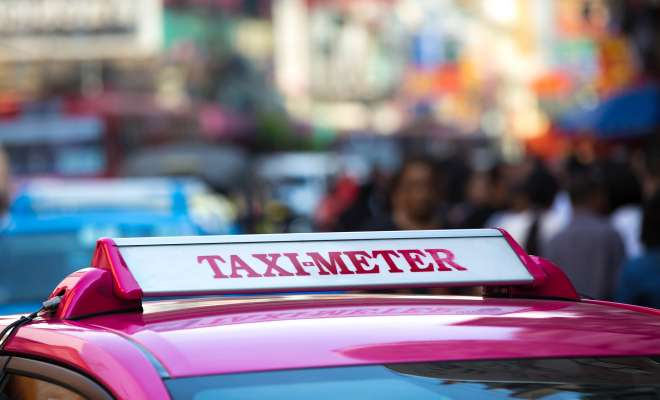
Avoid the taxi touts who will be waiting at the airport exit and who overcharge or who will direct you to hotels they have a commission with. In addition to the touts, there are likely to be genuine officials managing the taxi flow — they can be quite helpful. Use your common sense to tell the touts from the officials.
Mai Linh is a taxi company with a very good reputation, operating in both Ho Chi Minh and Hanoi, and which doesn’t overcharge. There is often a queue of Vietnamese and foreigners for Mai Linh taxis — ask for it if you can’t see the queue.
Fares back to either airport from downtown are regulated — eg about 220,000 Dong from the Old Quarter in Hanoi to Noi Bai airport; check with your hotel for the latest regulated fare, which is also displayed on a sticker within the cab.
There are also a number of companies offering pick up and transport to your hotel by private car. In our experience this can be cheaper, easier and more comfortable than taxis and we recommend it.
Search TripAdvisor for companies that have good reviews and offer a pre-paid booking service over the Internet. Someone will be waiting with a sign with your name on it at the airport exit. Note that Other Path Travel also operates an airport transfer service for our customers, that can be specified at the time of booking.




